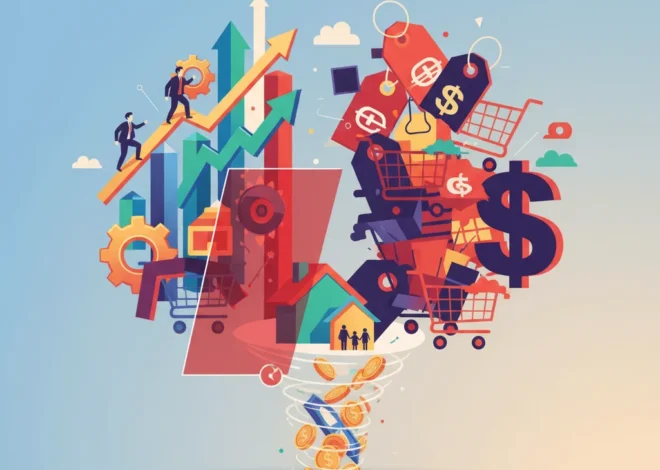
The 90s Economic Boom: Why We’re Learning the Wrong Lessons from the Clinton-Era Miracle
The 1990s. For many in the worlds of finance and investing, the decade evokes a potent sense of nostalgia. It was a time of seemingly effortless prosperity—the dot-com boom was in full swing, the U.S. federal budget was running a surplus, and the economy was firing on all cylinders. A common narrative, often repeated in discussions about replicating that success, credits the “strong dollar” policy of the Clinton administration as the primary catalyst for this golden era. But what if this widely accepted lesson is fundamentally wrong?
In a compelling letter to the Financial Times, economist Willem Thorbecke argues precisely that, suggesting that attributing the 90s boom to a strong dollar is like “praising the rooster for the dawn.” The rooster crows, yes, but it doesn’t cause the sun to rise. Similarly, the strong dollar was a symptom of the era’s success, not its cause. Misunderstanding this crucial distinction has profound implications for today’s economic policy, from banking regulation to stock market forecasts.
This post will deconstruct the myth of the strong dollar, explore the true engine of the 1990s economic machine, and analyze the cautionary tales that era holds for today’s investors, business leaders, and policymakers navigating a world of AI, fintech, and unprecedented global challenges.
The Virtuous Circle: Deconstructing the Real Engine of 90s Growth
The popular narrative is simple and seductive: A strong currency signals national economic strength, attracts foreign investment, and keeps inflation in check by making imports cheaper. While a strong dollar can have these effects, focusing on it as the primary driver misses the entire story. Thorbecke points to a far more powerful “virtuous circle” that was set in motion by a force that reshaped the global economy: the Information Technology revolution.
Let’s break down the sequence of events as they actually happened:
- The Productivity Boom: The widespread adoption of personal computers, the internet, and early financial technology created a massive surge in productivity. Businesses could operate more efficiently, communicate instantly, and manage supply chains with unprecedented precision. This wasn’t just incremental improvement; it was a fundamental shift in how work was done. According to the U.S. Bureau of Labor Statistics, nonfarm business sector productivity grew at an average annual rate of 2.6 percent from 1995 to 2000, a significant acceleration from the preceding two decades.
- Tamed Inflation and Low Interest Rates: This surge in productivity was the magic ingredient that allowed the economy to grow rapidly without triggering runaway inflation. As companies produced more with less, they could absorb rising demand without hiking prices. Federal Reserve Chairman Alan Greenspan famously recognized this dynamic, allowing the economy to “run hot” while keeping interest rates relatively low. This monetary policy was a direct response to the real-world effects of the tech boom.
- A Roaring Stock Market: With low interest rates and corporate profits soaring on the back of productivity gains, the stock market took off. The Nasdaq, a proxy for the burgeoning tech sector, became the epicenter of a historic bull run. This boom in the stock market created immense wealth (at least on paper) and fueled a wave of consumer and business confidence.
- The Influx of Foreign Capital: This is where the dollar enters the picture. International investors, seeing the incredible returns available in U.S. markets, poured capital into the country to buy stocks and bonds. To do so, they first had to buy U.S. dollars.
- The Strong Dollar Emerges: This massive global demand for the dollar was what caused its value to appreciate. The strong dollar was the final outcome—the capstone on an economic structure built on a foundation of technological innovation and productivity. It wasn’t the foundation itself.
Understanding this sequence is critical. It reframes the entire discussion from a simple currency policy to a complex interplay between technology, monetary policy, and global capital flows. The real hero of the 90s wasn’t the dollar; it was the microchip.
Beyond the Headlines: Navigating Geopolitical Risk in the Modern Financial Landscape
The Hidden Cost: The Dark Side of a Persistently Strong Dollar
While the strong dollar was a sign of a booming economy, its persistence created significant and lasting damage that is often glossed over in nostalgic retellings. As Willem Thorbecke warns in his letter, a strong currency is a double-edged sword. While it makes imports cheaper for consumers, it makes U.S. exports more expensive for the rest of the world and puts domestic manufacturers in direct competition with cheaper foreign goods.
The consequences were severe:
- A Ballooning Trade Deficit: The U.S. trade deficit expanded dramatically during the late 1990s and early 2000s. Americans, flush with wealth from the stock market, bought imported goods, while American-made products became less competitive abroad. This imbalance meant the U.S. was consuming far more than it was producing.
- The Hollowing Out of Manufacturing: The combination of a strong dollar and new trade agreements accelerated the decline of American manufacturing. Factories closed as companies moved production offshore to lower-cost countries, a trend that devastated communities across the American Rust Belt and Midwest.
- Fuel for the Dot-Com Bubble: The flood of “dumb money” from overseas, chasing high returns without adequate due diligence, helped inflate the tech bubble to unsustainable heights. When the bubble inevitably burst in 2000-2001, it wiped out trillions in market capitalization and tipped the economy into recession.
To put the economic conditions in perspective, here is a comparison of key metrics from the late 90s boom and the recent post-pandemic era.
| Economic Indicator | Late 1990s (1995-1999 Avg.) | Early 2020s (2021-2023 Avg.) |
|---|---|---|
| Annual Real GDP Growth | 4.4% (source) | 3.5% (source) |
| Annual Inflation Rate (CPI) | 2.5% (source) | 5.4% (source) |
| Effective Federal Funds Rate | 5.3% (source) | 2.5% (source) |
| Nonfarm Productivity Growth | 2.6% (1995-2000) | 0.6% (2021-2023) |
| Trade Deficit (Goods & Services) | -$181 Billion (Avg.) | -$887 Billion (Avg.) |
This data clearly shows that while recent GDP growth has been strong, it has been accompanied by much higher inflation and significantly weaker productivity growth, forcing the Federal Reserve into a much more aggressive stance than in the 1990s. The trade deficit has also grown exponentially, highlighting the long-term structural imbalances that began in that era.
The New Weapon in Wall Street's Debt Wars: Hedge Funds Unleash Antitrust Law
Lessons for Today’s Economy: From Investing to Policy
Getting the history of the 90s right isn’t just an academic exercise. It provides a critical framework for making better decisions in today’s complex financial landscape, which is being reshaped by forces like decentralized finance, blockchain, and AI-powered trading.
For Investors and Finance Professionals:
The primary lesson is to look past simplistic narratives and focus on fundamentals. The dot-com bubble taught a painful lesson about what happens when market valuations become detached from underlying profitability and productivity. Today, as capital floods into AI and other emerging technologies, investors must ask the hard questions: Is this technology genuinely increasing efficiency and creating value, or is this just hype? The strength of the dollar is far less important to a company’s long-term success than its ability to innovate and execute. Modern trading platforms and the rise of fintech have made it easier than ever to get caught up in momentum, but sustainable investing always comes back to real-world value creation.
For Policymakers and Business Leaders:
The focus should not be on engineering currency strength but on fostering an environment for the next productivity boom. This means strategic investments in education, R&D, and infrastructure that enable technologies like AI, blockchain, and advanced manufacturing to flourish. Furthermore, policymakers must be clear-eyed about the trade-offs. A policy that benefits the finance sector through a strong dollar may simultaneously harm the industrial sector. A holistic economic strategy requires balancing the interests of Wall Street and Main Street, ensuring that the gains from technological progress are broadly shared and don’t exacerbate the very inequalities that the 90s boom left in its wake.
The £20 Billion Tightrope: Can the Next UK Government Avert a Fiscal Crisis?
Conclusion: Building a Sustainable Future, Not Recreating the Past
The 1990s economic boom was a remarkable period, but it was a product of a unique convergence of technological revolution, deft monetary policy, and a specific global context. As Willem Thorbecke correctly identifies, its engine was productivity, and the strong dollar was merely a reflection in the rearview mirror.
To chase a “strong dollar” policy today in the hopes of recreating that magic would be a profound mistake. It would risk repeating the errors of the past—inflating asset bubbles and sacrificing domestic industry—without the underlying productivity miracle to sustain it. The real lesson of the Clinton era is that true, sustainable prosperity is not built on financial engineering or currency manipulation. It’s built on innovation, efficiency, and the hard work of creating tangible value. That is the lesson we must apply to the challenges and opportunities of the 21st-century economy.


